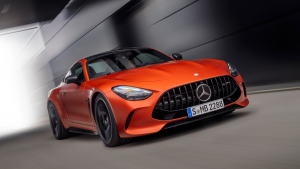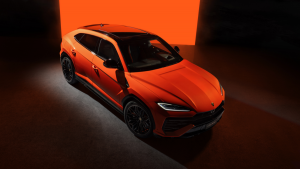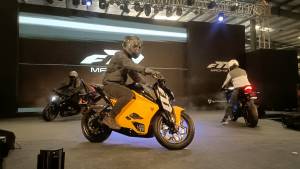The Rs 10 lakh track test
Ford Figo vs Maruti Suzuki Swift
Pure finesse
The Swift, India's hottest hatch should brush aside the upstart Figo, right? Think again
The Ford Figo goes up against the best hatchback we have seen in India so far, the Maruti Suzuki Swift. Often dubbed as a hot hatch, the Swift's performance, handling and design are the benchmark for all hatchback manufacturers in India. So how does this relatively new Ford match up against the most applauded hatch in India? Pretty darn well, I must say. If you compare these two cars by numbers, the Swift's 1.2-litre engine produces 85PS of power and 113Nm of torque while the Figo's 1.2-litre engine produces 71PS of power and 102Nm of torque. In terms of weight, the Swift tips the scale at 980kg while the Figo weighs 1040kg. In a straight line the Swift is a whole two seconds quicker than the Figo to the 0-100kmph mark. It may seem that the Swift certainly has the edge over the Figo in terms of numbers. But I'm afraid that isn't how it turned out. Handling is a crucial element on the racetrack and a better handling car even with slightly less power can gain those valuable seconds over the competition and that's exactly what happened here. The Figo's handling received praise not only from Karun but from all our jury members and this improved handling reflects in its lap time against the Swift. The Figo completed the lap a whole second quicker than the Swift at 2min 31sec while the Swift managed 2min 32sec. You have to work extra hard to hold on to your lines in the Swift while the Figo manages the corners effortlessly. In spite of the Swift's slick gearshifts, better throttle response and additional power, it just doesn't enter and exit corners with the finesse of the Figo. Even our rally driver judge Gaurav Gill, praised the Figo's handling and assumed that Ford's engineers have actually tuned the chassis dynamics, steering, and suspension geometry according to the tyres and road conditions of India, something which can't be done to the other international cars (like the Swift, Fabia or Polo) which are developed in Europe and then modified for use in India. The Figo runs 175/65 R14 tyres while the Swift uses 165/80 R14 tyres, another crucial factor that works in the Figo's favour. The wider, lower profile tyres help immensely in terms of grip which just seems to go on and on.
What Karun said
The Figo has a very responsive front end which helps it go faster round corners and it's slightly stiffer than the Swift which spells better control. The chassis felt like it could handle a lot more power and this car certainly feels underpowered when you look at its overall performance. The Ford Figo is certainly one of the better cars I have driven on this racetrack. The Swift is great fun on the track; you can throw it around a lot and is an ideal car for the beginners. It lacks power but then again compared to the Figo it certainly feels more powerful. The Swift's handling is overshadowed by the Figo and it needs more grip entering and exiting corners.
Maruti Suzuki SX4 vs Toyota Etios
Fresh heir
The newcomer Etios bumps bonnets with Maruti's flagship sedan, the SX4
The Toyota Etios has brought about a revolution in the market. Not only is it one of the cheapest sedans you can buy in the country right now, it also offers best interior space and a brilliant petrol engine which is frugal yet powerful. We pitched it against Maruti Suzuki's flagship sedan, the SX4. The SX4's 1.6-litre engine puts out 105PS of power and 145Nm of torque while the Etios' 1.5-litre mill produces 90PS of power and 132Nm of torque which might make it appear slower on paper but don't jump to conclusions just yet. Back to back on the track, the Etios is a whole six seconds quicker than the SX4. Surprising as it may seem, the competition once again boils down to handling. The SX4 has way too much body roll compared to the Etios and readily loses composure the moment it's pushed out of its comfort zone. The Etios on the other hand handles pretty well and remains planted even around tight corners. I also overheard Karun grumble about the rubber on the SX4. He said that the Etios certainly has superior tyres which offer good grip and allows the car to be pushed harder around corners. What Karun said The SX4 is a good all round performer with good engine responsiveness and ideal gear ratios for the circuit. The engine and chassis response are pretty impressive but it has a bit more body roll and sometimes when you change directions it moves too much from one side to the other but apart from that it is a pretty good all round performer. The Toyota Etios surprised me actually. It handles really well and I was very impressed with the chassis response and it changes direction extremely well. In terms of power it wasn't too bad for a car in this segment. All round, it's a surprisingly good car.
Skoda Fabia 1.6 vs VW Polo 1.6
Filial flair
The Fabia and Polo engage in a family feud
A classic case of sibling rivalry, the VW Polo 1.6 finally goes up against the Skoda Fabia 1.6 on a race track, an itch I wanted to scratch since the Polo entered our market. Both cars share the same engine and drivetrain while the Fabia is based on the previous generation PQ24 platform and the Polo on the PQ25 platform. It doesn't make a noticeable difference in terms of chassis dynamics as the PQ25 just allows for an all-wheel-drive to be bolted on while the PQ24 doesn't. The Polo looks like a natural performer with its bigger tyres, low stance and sharp lines. The taller and the sober looking Fabia on the other hand tries hard to get into the sporty garb and do justice to the 105PS 1.6-litre engine hiding underneath the hood. The only thing that seemed to be in favour of the Fabia was the Polo's kerb weight. It is 45kg heavier than the Fabia and that had the potential to be its Achilles heel, and I guess it did. According to Karun, it felt front heavy and tended to understeer while the Fabia held its line much better. Since both share the same underpinnings, I doubt that the brake bias is different in these cars. The Polo's understeer could be attributed to a front brake bias, and I think the overall weight distribution has something to do with it. Another reason I can attribute to the Polo's understeering characteristic is the profile of the tyres. The Fabia runs 185/60 14 tyres whereas the Polo runs 185/60 15 tyres. The additional inch in the diameter and the profile ratio results in the sidewalls buckling too much under pressure which induces understeer and thus makes the car lose a bit of time. Even though in theory the two cars should have near identical performance, on the track the Fabia is a whole six seconds quicker than the Polo 1.6, making the Fabia the fastest of the lot. The Fabia completed a lap in 2min 20sec while the Polo did it in 2min 26sec.
What Karun said
The Fabia's handling is actually pretty good with not much body roll. The engine could do with a bit more power and it felt like the chassis (being fantastic) is capable of handling much more power. Overall it's very enjoyable and a comfortable car to drive. It's very easy to place it wherever you want and the brakes are pretty good too. The Polo is a superbly built car and really nice to drive. It's easy and confident and the body roll isn't too much. Even though it has a similar drivetrain as the Fabia 1.6 it doesn't feel as quick in terms of performance. The handling is on par with the Fabia and it certainly is one of the best handlers among the cars on test here.
Mitsubishi Cedia vs Ford Fiesta
Party time
Will the Cedia's extra zip help it ease past the Fiesta?
Both the Cedia and the Fiesta have been around for a while and though both bear the 'sporty' tag, the Cedia with its Ralliart livery, sporty alloys and steering wheel leaves the Fiesta behind in terms of pure visual appeal. In terms of performance however, the cars are neck and neck, the Cedia just managing to gain a second on the Fiesta. The Cedia crosses the line in 2min 26sec while the Fiesta manages to complete a lap in 2min 27sec. The Cedia's larger 2-litre engine produces 115PS compared to the Fiesta 1.6-litre's 101PS. The Cedia also produces much higher torque at 175Nm compared to the Fiesta's 146Nm and in theory it should be much quicker than the Fiesta. But it isn't and the reason for that is the Fiesta's sharp handling which the Cedia can't keep up with. Just like the Figo, the Fiesta too is dynamically inclined with a very responsive front end. Karun, who prefers braking late found the Fiesta to be much more comfortable on the track compared to the Cedia. The Cedia is also slightly heavier than the Fiesta and that takes a toll on its lap time too. The Fiesta was and still is the best driver's car under the Rs 10-lakh mark. Last year it dismissed the Honda City in terms of handling and this year it showed the Cedia the door by impressing everyone with its magical handling characteristics. Unlike the Cedia, you don't have to wrestle with the steering every time you pile the car into a hard corner and the feedback from the steering tells you everything you want to know about the car, where it's heading and the way it will exit. The Cedia which is tuned more for comfort than handling tends to roll excessively and isn't encouraging on the circuit.
What Karun said
The Mitsubishi Cedia is not too bad and is a generally okay car. From the way the chassis felt, I think that this car could do with a lot more power and a slightly stiffer suspension. The car understeers much more than the Fiesta which I think can be attributed to its soft suspension and the set-up feels like it is tuned for a plush ride on the road rather than corner carving on the circuit. The Ford Fiesta, like the Figo has a very good front end and very good handling. It's extremely responsive and the steering response is fantastic. It's nice to drive in terms of stability and handling on the track. It could do with a bit more power but I guess all the cars under Rs 10 lakh have roughly the same power rating. The Fiesta leaves nothing to complain about.
Fiat Linea T-Jet
The Line T-Jet is put through the paces
I remember being at the launch of the Linea T-Jet in Mumbai. The launch AV had lots of footage of the car being pushed to its limits on a track, going sideways, sliding, and drifting while some of the most renowned motorsport drivers in India pledged testimony to the Linea T-Jet's handling and performance. It was clear that Fiat wanted to promote this car as a performance-oriented car and now we have put that very same to the test. Off the line, the Linea feels immensely powerful especially if the last car you drove was the Figo and the 0-100 time is one of the quickest in its category. Though the Linea is being marketed as a performer, it looks like a beautifully sober family sedan. Unlike the Cedia, Fiesta and the SX4 which have sporty intent embedded in their design, the Linea has graceful curves and subtle modulations on its surface which don't really make you want to push it to its limits. Since I wasn't here for a leisure drive in it, I had no choice but to go against my feelings and subject the Linea T-Jet to a merciless and thorough thrashing around the track and then to make things worse, Karun took it for a spin too. The Linea's FIRE engine pushes out 114PS of power but it's the phenomenal 204Nm of torque at a mere 2200rpm that results in the hurried manner with which the Linea surges forward. The wide 205/55 R16 tyres offer plenty of grip but do struggle for grip when you floor the pedal at the start line. The ride is comfortably smooth on normal roads and satisfyingly stiff on the track. In spite of being the biggest (in terms of size) car in this test, the Linea behaved much like a hot hatch, not losing its rear at every tight corner. Tyres offer excellent grip and body roll is also minimal. However like all Fiats, the Linea's steering doesn't provide enough feedback and the feel is a bit lifeless. On the track the Linea came second in our test with a lap time of 2min 21sec, a second more than the fastest car in this test, the Skoda Fabia 1.6.
What Karun said
The performance of the Fiat Linea was a real surprise. It's a very responsive and very driveable engine. The suspension is set up a bit on the soft side but it doesn't affect the handling too much and the car is very good while changing directions and entering and exiting the apex. The engine responsiveness coupled with this sort of handling makes it a fun car to drive on the track.
VW Polo Cup Car
Race pace
A dash in the Race Polo to put things in perspective
The Race Polo is the informal benchmark which we are testing all other cars against. Even though you will argue that it's not fair to pitch road cars against a proper race car., we are doing it just to give you an idea of how close the budget road cars come to the budget race car. The Race Polo is a stripped down Polo specially developed in Germany. It uses a 1.6-litre diesel engine which produces 130PS and has race suspension, a roll cage, light weight bucket seats and sticky racing rubber. It is a hot place to be in because this isn't a car you drive with the air con switched on, though it is available. The car has superb grip but Karun reckoned it would do even better with slightly stickier tyres. The engine has a superbly linear torque spread and so much of it everywhere that you can attack the track in 4th or 5th gear without losing speed. It's very stiff and specially developed for the track which makes it easy to maneuver. The car is deafeningly loud and doesn't feel very quick when moving until you look down and see a 140 midway through the back straight - and it's not a very long straight, mind you. The car does have a slight understeer engineered into it to keep the racing safer. This fully done up Polo Cup car completed a lap in 2min 03sec and when we use it as a benchmark, none of the budget road cars seem that bad, not even those that are half a minute slower. These road cars have much more weight, are designed for comfort and not outright sharp handling and have an engine tuned to strike a balance between performance and fuel economy.
Starts Rs 7.06 Lakhs
1368cc
Manual
90
210
-NA-
Starts Rs 7.75 Lakhs
1194cc
Automatic
96
119
16 Kmpl
Starts Rs 10.9 Lakhs
1497cc
Manual
100
145
17.8 Kmpl
Starts Rs 5.73 Lakhs
1197cc
Automatic
89.73
113
23.76 Kmpl
Related Stories
Top Stories
Latest Videos
Most Popular
- Budget Sportbike Showdown: Kawasaki Ninja 500 vs Aprilia RS 457 vs Yamaha YZF-R3
- 2014 Triumph Daytona 675 vs 2024 Kawasaki ZX6R - A Decade of Evolution in Supersport Motorcycles
- Mumbai-Pune Expressway speed restrictions updated
- Nissan Magnite EZ-Shift review - is the AMT any good?
- Nitin Gadkari states that tax on Hybrids should be reduced to 12 percent in the coming future














